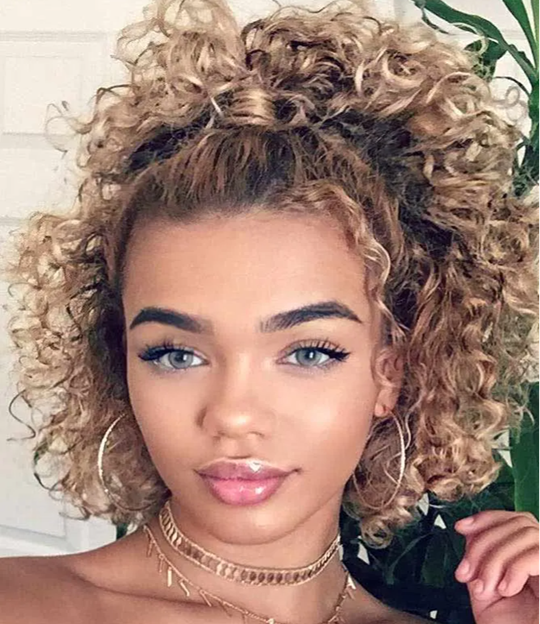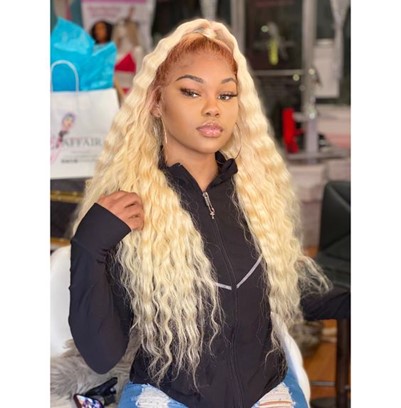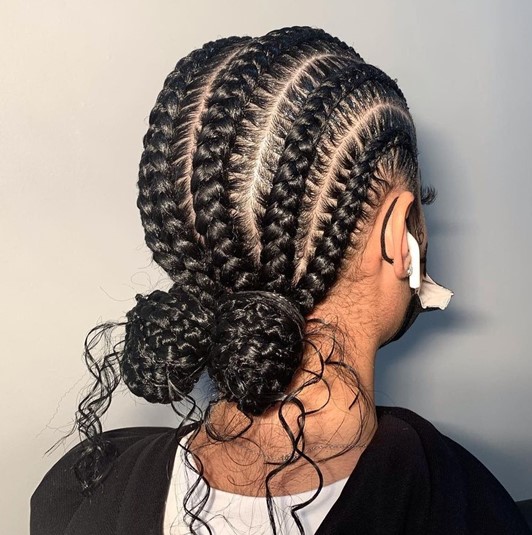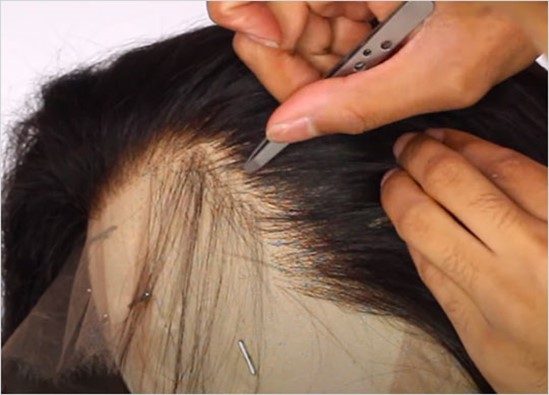Contents
How to use lace front lace wigs to make half sew in with braids style
Cornrow braids with curly hair at the back, known as Fulani braids with curls, are hot right now, and we’ve got all the information you need to know about this hairstyle.
For this look, it is best to use human hair rather than synthetic hair. Link to the hair/products highlighted with yellow throughout the article, and use them.
Sew-ins, wefts, and weaves can all help your natural hair grow faster while still looking chic. With a sew-in, you can conceal your own hair while it grows. To avoid damaging your hair like some glue-based weaves, these are sewn directly into it. Make an appointment at your local salon to get half-up, half-down sew-in hairstyles because an expert is needed. 5 ways to style a half up, half down sew in hairstyle will make you the talk of the town!
For this hairstyle, you’ll need:
1) Shine n jam.
2) A rat tail comb.
3)1 to 2 packs of prestretched xpression kanekalon hair.
4) A hair needle & thread.
5) Wig cap.
6) 2 to 3 curly deep wave human hair bundles or the water wave wet and wavy bundles.
- Hair glue.
Part One: Creating Your Base Braids
- Step one is to wash and condition your hair. After you’ve washed your hair as usual, be sure to condition it well. Before you begin the cornrowing process, make sure your hair is completely dry.
- This is the second step. Your natural hair will be parted in the middle, and you’ll layer your Brazilian hair weave around that section. If you have a visible part, it’s in the middle or slightly off-center of your scalp. Decide where you want the part to go, and then section off your hair into 12-inch sections on either side of it. Make use of the clips in order to keep your hair in place. Any hair that isn’t going into the weave should be separated and pinned up (edges, the crown of the head, nape of the neck, etc).
- This is the final step in braiding the outer row. Starting at the nape of your neck, braid a small section of hair that wraps around your face and around your head. On either side of the part, you’ll begin the perimeter braid, but you’ll finish it at the base of your neck. Remove the hair clips from your hair and cut a 14-12 inch wide section of hair from the crown of your head to the nape of your neck. Take your part’s edge-braid and wrap it as far around your head as you can. After that, repeat the process on the opposite side.
- Begin the braids in the center. You’ll end up with full braids that wrap around your head from the two braids you started on either side of your part. As a bird’s-eye view of your finished head, there will be a series of concentric circles. Section off a small section of hair at the outer edge of the braid and work your way inward, mimicking the pattern of the perimeter braid. Continue braiding from your hairline to the back of your head by braiding on either side of your part.
Part Two: Sewing the Weave Hair
- The first step is to bind the wefts together with a knot. Weft is another term for a single hair extension. The softness and fullness of Brazilian curly hair bundles make them ideal for use in a sew-in.
- Fold your weft in half if you want to add more volume. When the weft is unfolded, insert your needle into the weft’s unfolded edge to hold it together..
- To begin, sew the first stich. Using the weft as a guide, insert your needle and thread under the cornrow and bring it up. The curved needle should make this simple, and the needle’s point should now be facing you.
- The extension is now attached. Make a small incision just below the seam, and place the needle so that the point faces you. This is known as the track. Always make sure that your needle goes under both tracks when working with a folded weft. Try to conceal the cornrow with the human hair extension held high. Make a loop by inserting the needle under the cornrow and gently pulling the thread out.
If your cornrow extended beyond your part, simply fold it back onto the head as you attach the extension.
- Make a knot at the end of this step. Using the needle and thread that you just brought up from behind your cornrow, pull the thread through to the other side. To ensure that the extension is firmly attached, give it a firm tug.
- Step 5: Keep sewing as you normally would. About a 12 inch away from your final stitch, re-insert the needle under the extension’s track. You can secure your extension by sliding the needle under the cornrow, leaving a loop, and then bringing the needle and thread through the loop. Keep your stitches neat and uniformly spaced at a 1/2-inch intervals as you sew your extension along the part line.
- Sixth and final step: the row comes to an end. Insert the needle through the front of the extension and tack the two folded ends of the extension together when you’re one stitch away from the end. You must not pass through the cornrow ever again. Using a needle and thread, sew two or three stitches into the folded end to secure it. Now take an extra needle and knot it by inserting it into one of the stitches before pulling it through to make another stitch. For added safety, tie a double- or triple-knot at the end. Cut off the excess thread at the extension’s two ends.
Part Three: Installing Your Lace Closure
- The first step is to use a bleach solution to remove the knots. The hairline can be thinned if necessary with tweezers, so that it is not the same density all the way down. There is nothing more unnatural than having a hairline that ends abruptly, which is why you don’t want the edge of your hairpiece to have the same density of hair throughout and then abruptly end.
- 2. Align the closure so that your natural scalp shows through the lace when it is applied. To hide any knots that haven’t been completely bleached, some women use a foundation or concealer that matches their skin tone.
To make braiding easier, keep spritzing your hair with the oil/water mixture or your detangler spray.
You should be able to feel the pain as you braid, but the finished product should not be painful.
With so much hair, the braids will likely get quite thick around halfway through. Your braids will not be uneven as a result of this.
Types of Feed In Braids for You to Choose From Now comes the fun part!
For your viewing pleasure, we’ve compiled a list of the best feed-in braid styles! Become enchanted, become inspired, and when you do, be sure to tell your hairstylist about your newfound love for the look!
Source: https://www.hadviser.com/feed-in-braids/
1. A Touch Of Gold To Your Curly half sew in with braids in front
Show off your gorgeous curly half-up, half sew in with braids in front Gold accents in the hairstyle. Wrap your curly half in a golden thread and wear it with any outfit; this is a great styling method for any occasion. Your weaves will appear more luscious with a generous application of mousse.

2. High Deep Curly Half-Up, Half-Down
Make your half-up, half-down sew-in look even better by using a mousse to enhance your curls. Wrap a small section of the weave hair around the ponytail and secure it with a high-knot. This partial sew-in allows you to create stunning hairstyles that are also simple to style. For women with naturally thick and long hair, the tracks won’t be noticeable.

3. Half-Up, Half-Down Top Knot Sew-In With Split Bangs
If you’re not used to sewing in weaves, schedule an appointment at a salon to get this stylish top knot partial sew-in hairstyle with face-framing split bangs. A top knot hairstyle that looks natural and lasts for up to eight weeks is ideal for those with busy schedules. If you want to get this gorgeous look, just follow these simple instructions:
- Create a section from ear to ear and cut out a thin line. With the latter, the tracks can be hidden.
- Braid the bottom half of the section while tying the top section away.
- After braiding, attach a net to the bottom half by sewing it in.
- Make a clean cut of the net.
- Sew the bundles from the bottom up with your weave hair. Sew the hair in place until it completely covers the bottom section.
- Using a hot comb, untie the top section and comb it.
- To get the split bangs, take a section of hair from the crown of your head and tie it back.
- Use a flat iron to straighten the rest of the hair, then mousse it and twist it into a bun. Sleekness is achieved through the use of edge control.
- In order to secure the bun, wrap a section of weave hair around it.
- To lengthen the bangs, use a hot comb, flat iron, and two pieces of glue hair. To achieve a more natural look, use shear scissors to cut the bangs short.
- Style your split-bangs however you like after you’ve finished customizing them.
Pro tip: Create natural-looking waves with a curling wand or flat iron to your loose sections, and you are done.
What Are Feed-In Braids, Their Pros and Cons
What are feed in braids?
It is a type of braided hairstyle in which extensions are woven into a braid from the bottom up, rather than simply being attached. That’s why you’ll see a lot of braiders “feeding in” strands of their own hair to the main braid, so that it grows in size over time.

Why are they called feed-in braids?
Feed-ins are known as this because you can insert small sections of hair extensions into the plait as you build it up.
Are feed-in braids a protective style?
Braids that have more hair in them appear fuller, less frizzy, and longer. An important part of many braided designs is using the feed-in method.
What is the difference between feed-in braids and cornrows?
The method of braiding is what makes the difference. A single strand of hair is added for the cornrows, and then a knot is tied at the start of the plaiting process before it’s completed. Synthetic hair is fed into braids several times without tying it in first, as in feed-in braids.
How long do feed in braids last?
Hairstyles with feed-in braids last for a maximum of two weeks. Using a few tricks, you can extend the life of them for up to three weeks..
How to install braids transparent lace closure
Transparent lace hair official mall customers are becoming more and more concerned about closure as a new arrival. In this article, we’ll show you how to flawlessly install a transparent lace closure.
The HD lace closure is the same as the regular lace closure, but how do you put it on? Sewing in hair weaves can be done at home if you have the skill set, but if not, you’re better off visiting a professional hairdresser.

- Put the transparent lace closure where you want it, and then press it down firmly. To keep the lace closure in place, you’ll need to secure it with a few clips. Typically, customers prefer to purchase a free-part closure that can be divided into any number of parts. Lace is translucent, which means you don’t have to worry about the color not matching your skin tone. Makeup is a good option if you want the color to match your skin tone.
- Second, sew the lace edge on your braid line on your head with a needle and cotton thread so that you won’t make any mistakes. You can sew along the edge of it and then proceed to sew on the next section. It will look more natural if you don’t sew the forehead. Don’t overtighten, however, as this will cause discomfort. Make sure the line continues to play all the way from the top to the back of the closure and that it is long enough. A more secure and reliable knot can be made by twisting your arm and threading the needle through there and pulling that thread to create a knot. You can repeat this process on the other side to further enhance security and reliability. To lay the closure flat on your head, you must apply some force to the closure. Because of this, the closure will not buckle in the middle of the garment. After sewing the two sides together, you should turn your attention to the closure’s back. Back stitching is a technique for picking up stitches in the opposite direction of where you left off when overlapping. We’re basically taking a backstitch with our closure.
- You’ll still need to adjust your closure once it’s sewn in place. You can remove a few hairs from the hairline to make it appear more natural. According to some customers, the thicker your wig is, the less natural it will look. You can tidy up any stray hairs with a pair of scissors if necessary.
- Finally, you can remove any lace that isn’t absolutely necessary. Just make sure to keep it secure and trim it neatly. You can then adhere it with glue. You can also add some baby hair to your wig to make it appear more realistic.